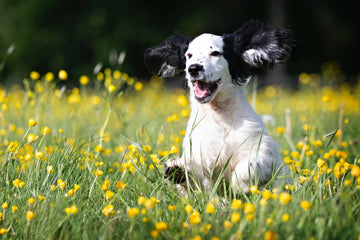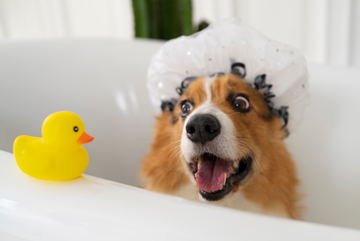Being a dog parent is a rewarding experience, but it also comes with its fair share of responsibilities. One of those responsibilities is ensuring that your furry friend stays clean, healthy, and comfortable. While trips to the groomer are great for the occasional deep clean, regular at-home grooming can be just as important. Plus, grooming at home is a wonderful way to bond with your dog and keep their coat, nails, and ears in tip-top shape between professional grooming sessions.
But let’s face it: grooming your dog at home can seem like a daunting task, especially if you’re not sure where to start. Don’t worry, though—whether your dog is a fluffy lap dog or a long-haired companion, these grooming hacks will make your life easier and your dog’s coat shinier and healthier.
So, grab your grooming tools, and let’s dive into some practical and simple tips to keep your dog looking and feeling their best at home!
1. Start with a Comfortable Setup
Creating a calm and stress-free grooming environment is essential. Before you begin, make sure both you and your dog are comfortable. Choose a quiet, well-lit area where your dog feels at ease, whether it’s a bath tub, shower, or even a pet grooming table.
If your dog is particularly nervous about grooming, try placing a soft towel or blanket under their paws for extra comfort. This will help them stay still during the grooming process. You can even try putting on some calming music to create a soothing atmosphere.

2. Brush Regularly for a Healthy Coat
Brushing your dog’s coat regularly is one of the most important parts of grooming. Not only does it help prevent tangles and mats, but it also removes dead hair and promotes circulation to the skin, which keeps it healthy.
The key to a good brushing session is choosing the right brush for your dog's coat type. For short-haired dogs, a simple bristle brush may suffice, while long-haired dogs may require a slicker brush or even a de-shedding tool to prevent mats and tangles.
Brushing is also an excellent opportunity to check for any unusual bumps, skin irritation, or parasites. It’s always a good idea to keep an eye on your dog’s skin as you brush them. If you spot any signs of discomfort, it might be time to schedule a visit to the vet.
3. Tackle the Nails with Care
Cutting your dog’s nails is one grooming task that can be intimidating for both you and your dog. However, keeping your dog’s nails trimmed is crucial for their overall health, as long nails can cause discomfort, lead to mobility issues, or even break.
To make nail trimming easier, start by using a high-quality pair of nail clippers designed specifically for dogs. If your dog is particularly nervous, consider using a Pet Electric Nail Grinder. These grinders are gentler and quieter than traditional clippers, making them ideal for sensitive pups. They can also help smooth out rough edges after trimming.
Take your time and trim a little at a time to avoid cutting the quick (the sensitive area inside the nail). If you’re unsure about nail trimming, start slow and use treats to reward your dog after each successful trim. With patience and practice, your dog will get used to the process.
4. Bath Time Made Easy
Bath time can be a bit of a challenge if your dog isn’t a fan of water, but it doesn’t have to be a stressful experience. First, be sure to use a dog-specific shampoo to keep your pup's skin balanced. Human shampoos can be too harsh, stripping your dog’s skin of its natural oils.
A gentle, calming dog shampoo, like the Squeaky Clean Shampoo Brush, can help you bathe your dog more efficiently. These brushes allow you to apply shampoo and massage it into their coat, while the soft bristles help to exfoliate their skin and work out tangles.
When it comes to rinsing, make sure to use lukewarm water—not too hot and not too cold. Start by wetting your dog’s coat slowly, using a cup or gentle sprayer. Massage the shampoo into their fur, then rinse thoroughly to make sure no soap is left behind.
If your dog is particularly anxious during bath time, try using treats, soothing words, and plenty of positive reinforcement to keep them calm.
5. Don’t Forget the Ears and Teeth
While brushing your dog’s coat and trimming their nails are essential parts of grooming, don’t forget about your dog’s ears and teeth! Cleaning your dog’s ears regularly can help prevent infections, especially in breeds with floppy ears. Gently wipe the outer part of their ears with a damp cloth or use a veterinarian-approved ear cleaner.
Similarly, brushing your dog’s teeth at home is vital for their dental health. Plaque buildup can lead to gum disease and other dental issues. Invest in a dog-friendly toothbrush and toothpaste, and brush their teeth a few times a week to keep their mouth fresh and clean.
6. Handle Paw Care Gently
Just like the rest of your dog’s body, their paws need special care too. Regularly check their paw pads for cuts, abrasions, or debris like small rocks or sticks that might get stuck. For long-haired breeds, consider trimming the fur between their paw pads to prevent dirt and ice from getting trapped.
One grooming tool that can make paw care much easier is an Electric Dog Paw Cleaner. This tool allows you to clean your dog’s paws quickly and efficiently after walks or outdoor play, ensuring they stay clean and healthy without the struggle.
7. Keep Your Grooming Tools Clean
Just as important as using the right grooming tools is maintaining their cleanliness. Brushes, clippers, and nail grinders can collect fur, dirt, and bacteria, which can lead to infections if not properly cleaned. Be sure to disinfect your grooming tools regularly to keep them in top condition.
After each use, wipe down your grooming tools with a clean cloth and wash them with mild soap and warm water. Make sure to let them dry completely before storing them. Proper maintenance of your grooming tools will make your grooming sessions smoother and more efficient in the long run.
Grooming for a Healthy, Happy Dog
At-home grooming is more than just about keeping your dog looking good—it’s about ensuring they stay healthy and comfortable. Regular grooming helps maintain your dog’s overall well-being, reduces the chances of health issues, and strengthens the bond between you and your pup.
By following these tips, you’ll be able to create a positive grooming routine that benefits both you and your dog. And don’t forget: grooming is a great opportunity to check for any skin issues, injuries, or discomforts, which might otherwise go unnoticed.
Whether you’re trimming nails, brushing fur, or giving your dog a bath, your pup will appreciate the love and care you provide. So, gather your tools, take it slow, and make grooming an enjoyable activity for both you and your furry companion. With the right approach, grooming can become a fun and rewarding part of your dog’s wellness routine—one bath, brush, and paw at a time!







